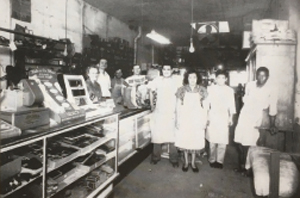A LITTLE PIECE OF HISTORY | By Joan Frances –

The Fort Bend County Fair Parade is seen here in the late 1940s as it passes the Cole Theater in the 900 block of Main Street. The judges from the parade stood on the marquee of the theater to better view the parade entries. Photos from Historic Downtown Rosenberg.
Think back, way back. It’s 1883 in Rosenberg Texas. Henry Rosenberg, President of the Gulf, Colorado and Santa Fe Railroad, purchased 200 acres of land. He had them platted around a city square between the river and the railroad. At first, Main Street was a typical old west town with only a post office. Residents lived in tents, and roads were either dusty or muddy; people nicknamed Rosenberg “Mud City.” With constant railroad traffic going into and out of the area, farmers and ranchers set out to build a city, one they could be proud of. Soon, a mercantile, saloon and a hotel invited travelers to stay. As time progressed, downtown Main Street became a bustling commercial center for entertainment and commerce.
In 1894, Wells Fargo opened a shipping office and soon many retail stores followed. Rosenberg’s population quickly grew to 1,000 people by 1900, and in 1902, it was incorporated. The first Masonic lodge was established in 1903. The first brick building, constructed in 1907, was J.H.P. Davis Bank, in the heart of the downtown. The Edward Walter Cummings Drug store opened from 1910 to the early 1920s and was considered a staple in the downtown area. The first telephone was installed and operated from there. By 1906, a switch board was set up in Kubena’s Boot Shop in the Moers Building, where 100 telephone subscribers communicated daily. The saloons in the area were equipped with a bar and dance floor. People would come by wagon and foot from miles around to hear local musicians play, to drink and to dance. By 1912, Rosenberg had 56 operating business, including the first electrical generating plant.
In 1919, Mr. Felcman and Mr. Podlipny purchased a lot on Main Street and built the Liberty Theater. Silent and talking movies were introduced to the public. This state-of-the art form of entertainment brought devoted patrons weekly. Another theater, built in 1936, was The State Theater. It showed Czech films and Spanish speaking movies. In 1937, Mart Cole Sr. purchased the Liberty Theater and renamed it the Cole Theater. With the help of architect Ernest L. Shult, he renovated it to a classic art deco motif on the front of the building, which is a historical marker today. Because of the theater’s popularity, community events, talent shows, concerts, and later, the Rosenberg Opry performances were held there. Movie Studios from California listed Rosenberg as a stopping point for movie stars promoting their films. John Wayne, Shirley Temple, Tom Mix, Gene Autry and Roy Rogers, to name a few, could be found outside the Cole Theater signing autographs and posing for pictures. For 64 years this iconic building entertained the city of Rosenberg. In 1983, the last movie played, earning a spot in the history books for the longest movie run in cinema history.

Kubena Boot and Shoe Shop’s first location on Avenue G. Pictured are owners Mary and August Kubena, an unidentified person, Alec Urbanski, Martin Ybarra and his wife, Simon Galica (owner after August Kubena) and James Mitchell.
Holidays were highly anticipated by the residents of Rosenberg. In the fall, when the weather was cooler and the harvest was made, people traveled from miles around to gathered and enjoy their good fortune. Thanksgiving was usually a three-day festival, filled with sharing delicious meats, fruits and vegetables. Sampling baked goods, singing songs, dancing to music by local musicians and playing games kept the holidays joyful. The celebration of Christmas was the highlight of the season. Hand-made ornaments, Christmas cards and wood-carved toys were traded and treasured. Religious traditions were observed, and Santa always made an appearance.
Today, these magical, deep-rooted traditions are still commemorated. Downtown Rosenberg has a tree lighting ceremony with all the merchants in the area joining to toast the holiday season. Rosenberg comes alive, just as it did over 100 years ago.